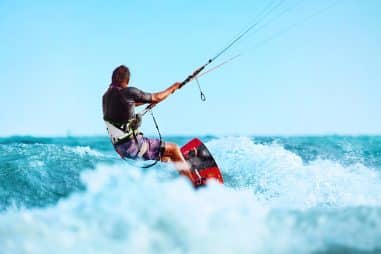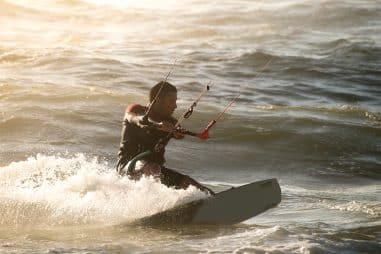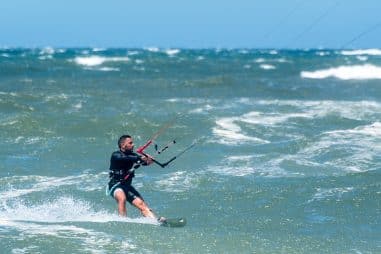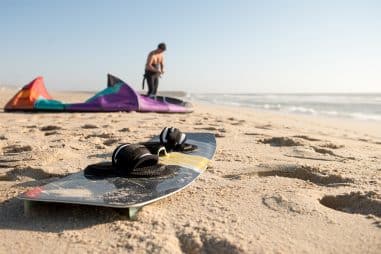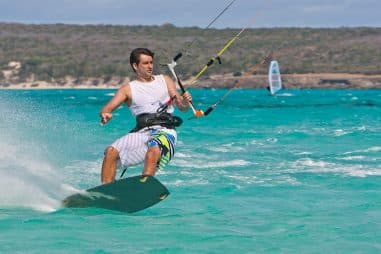The art of kite flying has been part of our history since time immemorial but kitesurfing as a modern-day sport is fairly new. But it is slowly getting the attention of riding enthusiasts all over the world and is slowly making its way as one of the top watersports in the world.
What Does Kitesurfing Involve?
Unlike other watersports that are focused on just one skill, kitesurfing is essentially the combination of different sports including wakeboarding, windsurfing, paragliding, surfing, snowboarding, and skateboarding.
Balancing on top of the board (whose characteristics are similar to that of snowboard, skateboard, and wakeboard), the rider is harnessed to a hand-controlled kite, and his movement and the direction of the board is powered by the wind.
How Does a Kitesurfing Kite Work?
People assume that kitesurfing kite flies with the wind but in reality, the kite flies through the wind much like the wings of an airplane.
A kite is acted upon by four forces namely lift, weight, drag, and thrust.
- Lift: This is the force that is pushing a kite upward and it is generated by the air pressure created by the air flow above and below the body of the kite. In order for the kite to move upward, the flow of the air above has to be faster than the air movement at the bottom.
- Weight: While the lift is the upward force, weight is the downward pull on the kite caused by gravity.
- Thrust: This is the forward force created by the tension from the lines and wind movement. Thrust propels the kite to the direction of motion.
- Drag: Drag is the opposite of thrust. This is the backward force caused by the friction of the air moving above and the difference in air pressure between the front and back of the kite.
How Fast Can a Kitesurfers Go?
On average, kitesurfers ride at around 15 to 25 miles per hour (mph) but this varies greatly on the skill of the person, the wind speed, the conditions of the water, the kind of board, and the size of the kite used.
While professional kitesurfers can go as fast as 50 to 60 mph, given the right wind and water conditions, a normal kitesurfer can double the average speed and clock at 40 mph.
How Do Kitesurfers Not Fly Away?
One fear that is associated with kitesurfing is flying away and not being able to come down. However, the science of kitesurfing eliminates this scenario completely.
Kites act like a wing for kitesurfers but it’s not possible for them to ceaselessly create upward lifts. Once you are riding, it’s impossible for the kite to take off like a hot air balloon until you are up in the air.
How Popular Is Kitesurfing?
Kitesurfing is not the most popular watersport but in recent years, it has started getting traction. People that used to windsurf had slowly transitioned to full-on kitesurfing as they claimed that the sport gives off more buzz.
Kitesurfing enthusiasts go out of their way to visit kitesurfing meccas including Mui Ne in Vietnam to catch the wind. There are a lot of kitesurfing competitions around the world that cater to kitesurfers of all skill levels.
How Many Kitesurfers Are There in the World?
In 2008, all the kitesurfers in the world were only estimated to be 250,000 but it has significantly increased in recent years. Today, there are estimated to be several million kitesurfers of all ages, genders, and races all over the world.
The number of kitesurfers is expected to come up as people discover more kitesurfing spots in the world. People have come to established kitesurfing schools left and right to cater to new students who are excited to join the sport.
How Old Is Kitesurfing?
Kites were first used in China 2,800 years ago (mostly for sending messages, measuring distances, testing the wind, and communication for military ops) but it wasn’t until the 1800s when a kite was first used to move vehicles.
The fundamentals of the sport can be traced back to 13th century China proving that the actual sport may be fairly new, the science of it has already been used by people many centuries back.
Who Invented Kitesurfing?
The invention of modern kitesurfing is attributed to three people. A Dutchman named Gijsbertus Adrianus Panhuise patented a watersport named kitesurfing in 1977. However, it did not gain any traction commercially.
It wasn’t until brothers Bruno and Dominique Legaignoux developed the kites being used for the sport in the late 70s and early 80s. They patented the design for an inflatable kite in 1984 and this was the model used by companies in developing their own kites.
Where Did Kitesurfing Originate?
The Legaignoux brothers developed the kite prototype on the Atlantic coast of France. The patented inflatable kite paved the way for the development of modern-date kitesurfing kites.
Their design enabled other innovators to come up with their own kitesurfing patents. These include the kite-ski by American father and son team up Bill Roeseler and Cory Roeseler. The Legaignoux brothers even designed another kite design called “Wipika” In 1996 until 1997/
Is Kitesurfing a Sport?
Kitesurfing is a water sport so intense and high-risk others even consider it as an extreme sport. It combines aspects of different sports including skateboarding, wakeboarding, paragliding, and snowboarding, surfing and windsurfing .
It is a sport that tests one’s endurance, core strength, balance, and focus among others. Kitesurfers need not only to be physically strong but they also need presence of mind and the ability to take on the challenge posed by the uncertainty of the elements of the wind and water.
Is Kitesurfing an Olympic Sport?
Kitesurfing has yet to be included as an Olympic sport. The World Sailing (WS), the international body overseeing sailing activities, has to propose to the International Olympic Committee (IOC) before kitesurfing becomes a full-pledge Olympic sport.
The good news is that there are a lot of kitesurfing competitions (both local and international) all over the world. Some of these competitions are being conducted in the world’s top kitesurfing spots including Haugastol in Norway, Zandvoort in the Netherlands, Cape Town in Africa, Cape Hatteras in North Carolina, and Melbourne, Australia.
Who Is the Best Kitesurfer in the World?
It’s difficult to definitively say who the best kitesurfer in the world is. One, kitesurfing has many legends, and two, kitesurfing involves several disciplines which makes it hard to rank all the biggest and most competitive kitesurfers.
Some of the kitesurfing legends include Mitu Monteiro, Matchu Lopes, James Carew, Liam Whaley, and Gisela Pulido.
Who Is the Kitesurfing World Champion?
Here is a list of kitesurfing disciplines and the kitesurfers currently dominating them.
| Discipline | Kitesurfing Champions | |
| Female | Male | |
| Strapless | Carla Herrera | Airton Cozzolino |
| Freestyle | Mikaili Sol | Valentin Rodriguez |
| Big Air | Kevin Langeree
Jesse Richman |
|
| Hydrofoil | Daniela Moroz | Theo de Ramecourt |
What Is Freeride Kitesurfing?
Freeride is considered to be the traditional and most popular way to kitesurf, and it’s most likely the first style that you will learn. This kitesurfing discipline involves moves from cruising to bumps, grabs, and performing tricks while riding.
Freeride often used the most basic and versatile of equipment. The most popular kite for freeride is the “delta shape” with a distinct D shape from the front and a flat profile. Freeride kitesurfing mostly uses the twin tip since it allows for a smoother ride.


